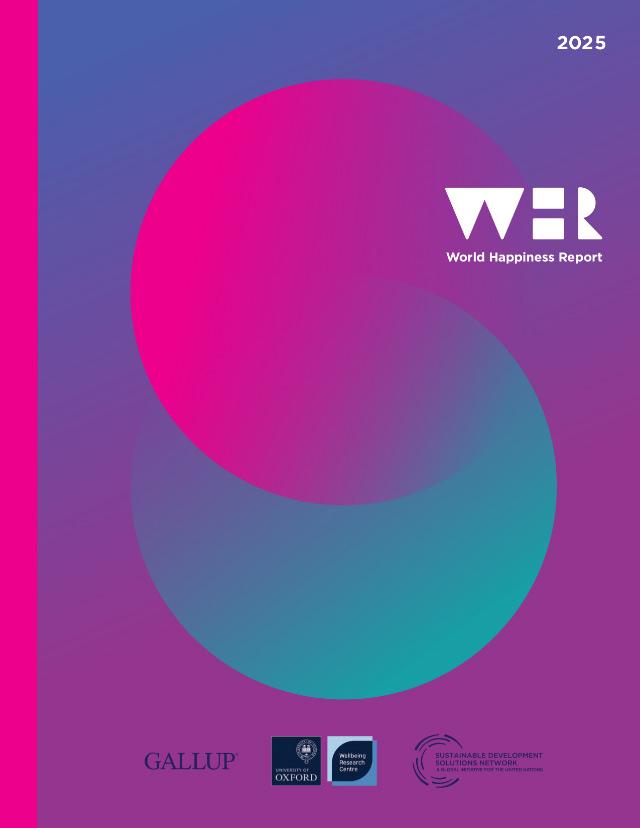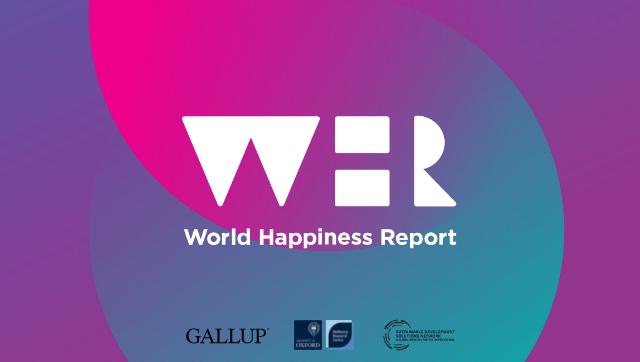World Happiness Report
Powered by Gallup, the World Happiness Report provides data-driven insights to the global conversation on happiness.
Thank you for downloading the World Happiness Report 2025.
You'll also receive an email with a link to download the report.
World Happiness Report 2025
The World Happiness Report is a partnership among Gallup, the Oxford Wellbeing Research Centre, the UN Sustainable Development Solutions Network and the World Happiness Report's Editorial Board.
The World Happiness Report has become an indispensable resource for satisfying the growing global interest in prioritizing happiness -- or wellbeing -- in policymaking. Gallup World Poll data on life evaluations are the primary source behind the annual happiness rankings for countries worldwide.
The report assesses the current state of happiness around the world and explores how the field of happiness science illuminates the differences in happiness levels on a global and national scale. The 2025 edition focuses on the effect that caring and sharing have on people's happiness, and as it does every year, reveals the happiest country on Earth.

World Happiness Report 2025
The World Happiness Report is a partnership among Gallup, the Oxford Wellbeing Research Centre, the UN Sustainable Development Solutions Network and the World Happiness Report's Editorial Board.
The World Happiness Report has become an indispensable resource for satisfying the growing global interest in prioritizing happiness -- or wellbeing -- in policymaking. Gallup World Poll data on life evaluations are the primary source behind the annual happiness rankings for countries worldwide.
The report assesses the current state of happiness around the world and explores how the field of happiness science illuminates the differences in happiness levels on a global and national scale. The 2025 edition focuses on the effect that caring and sharing have on people's happiness, and as it does every year, reveals the happiest
World Happiness Report
The World Happiness Report explores the factors contributing to human wellbeing, the happiness ratings of countries and the importance of measuring happiness.
Chapter 1: Executive summary
01 Executive summary
The executive summary of the World Happiness Report distills key findings, analysis and recommendations into a clear, concise overview. It provides a snapshot of the report's most important insights, allowing readers to quickly grasp the state of global happiness before exploring the full findings.
Chapter 2: Caring and sharing
02 Caring and sharing: Global trends in happiness and kindness
This chapter delivers the yearly rankings of nations based on average life evaluations of their residents. It also explores three Gallup World Poll benevolence measures -- giving donations, helping strangers and volunteering -- along with a Lloyd's Register Foundation World Risk Poll question about trust. Finally, it highlights the extent of international caring and sharing and their link to national happiness.
Download the Report to Get This Chapter --Caring and sharing

Chapter 3: Sharing meals with others
03 Sharing meals with others: How sharing meals supports happiness and social connections

This chapter presents new evidence on an understudied indicator of social connection: sharing meals. Unlike many social measures, meal sharing can be tracked across countries, cultures, individuals and time, revealing global differences. In some countries, nearly every meal is shared, while in others, people eat almost all of their meals alone -- patterns that are not fully explained by differences in income, education or employment.
Download the Report to Get This Chapter --Share meals with others
Chapter 4: Living with others
04 Living with others: How household size and family bonds relate to happiness
For most people, family is a primary source of joy. But does household size influence happiness? This chapter examines the relationships among happiness, household size and family bonds, turning to the specific characteristics of households in Latin America and Europe.
Download the Report to Get This Chapter --Living with others

Chapter 5: Connecting with others
05 Connecting with others: How social connections improve the happiness of young adults

Social connections are a crucial buffer against the toxic effects of stress, yet many young adults today struggle with social disconnection. In 2023, nearly one in five young adults worldwide reported having no one they could rely on for social support -- a 39% increase compared to 2006. This lack of connection has serious implications, as early social ties have long-lasting effects
Download the Report to Get This Chapter --Share meals with others
Chapter 6: Supporting others
06 Supporting others: How prosocial behavior reduces deaths of despair
This chapter's findings show a clear link between prosocial behavior -- donating, volunteering and helping strangers -- and fewer deaths of despair. A 10-percentage-point increase in prosocial engagement is associated with roughly one less death per 100,000 people each year.
Download the Report to Get This Chapter --Suppporting others

Chapter 7: Trusting others
07 Trusting others: How unhappiness and social distrust explain populism
This chapter explores how factors like life satisfaction and trust influence voting behavior more than traditional ideologies or class struggle. In both Europe and the U.S., declining happiness and social trust have fueled political polarization and a growing rejection of current political systems.

Chapter 8: Giving to others
08 Giving to others: How to convert your money into greater happiness for others
How much happiness does each dollar of charitable giving create? Using wellbeing-years (WELLBYs) per dollar as a measure, researchers find that some charities are dramatically more effective than others -- hundreds, almost thousands of times better at increasing happiness. This means donors can amplify their impact simply by choosing the most cost-effective organizations.

Chapter 1: Executive summary
01 Executive summary
The executive summary of the World Happiness Report distills key findings, analysis and recommendations into a clear, concise overview. It provides a snapshot of the report's most important insights, allowing readers to quickly grasp the state of global happiness before exploring the full findings.
Chapter 2: Caring and sharing
02 Caring and sharing: Global trends in happiness and kindness
This chapter delivers the yearly rankings of nations based on average life evaluations of their residents. It also explores three Gallup World Poll benevolence measures -- giving donations, helping strangers and volunteering -- along with a Lloyd's Register Foundation World Risk Poll question about trust. Finally, it highlights the extent of international caring and sharing and their link to national happiness.

Chapter 3: Sharing meals with others
03 Sharing meals with others: How sharing meals supports happiness and social connections

This chapter presents new evidence on an understudied indicator of social connection: sharing meals. Unlike many social measures, meal sharing can be tracked across countries, cultures, individuals and time, revealing global differences. In some countries, nearly every meal is shared, while in others, people eat almost all of their meals alone -- patterns that are not fully explained by differences in income, education or employment.
Chapter 4: Living with others
04 Living with others: How household size and family bonds relate to happiness
For most people, family is a primary source of joy. But does household size influence happiness? This chapter examines the relationships among happiness, household size and family bonds, turning to the specific characteristics of households in Latin America and Europe.

Chapter 5: Connecting with others
05 Connecting with others: How social connections improve the happiness of young adults

Social connections are a crucial buffer against the toxic effects of stress, yet many young adults today struggle with social disconnection. In 2023, nearly one in five young adults worldwide reported having no one they could rely on for social support -- a 39% increase compared to 2006. This lack of connection has serious implications, as early social ties have long-lasting effects
Chapter 6: Supporting others
06 Supporting others: How prosocial behavior reduces deaths of despair
This chapter's findings show a clear link between prosocial behavior -- donating, volunteering and helping strangers -- and fewer deaths of despair. A 10-percentage-point increase in prosocial engagement is associated with roughly one less death per 100,000 people each year.

Chapter 7: Trusting others
07 Trusting others: How unhappiness and social distrust explain populism
This chapter explores how factors like life satisfaction and trust influence voting behavior more than traditional ideologies or class struggle. In both Europe and the U.S., declining happiness and social trust have fueled political polarization and a growing rejection of current political systems.

Chapter 8: Giving to others
08 Giving to others: How to convert your money into greater happiness for others
How much happiness does each dollar of charitable giving create? Using wellbeing-years (WELLBYs) per dollar as a measure, researchers find that some charities are dramatically more effective than others -- hundreds, almost thousands of times better at increasing happiness. This means donors can amplify their impact simply by choosing the most cost-effective organizations.

The World Happiness Report is a partnership among Gallup, the Oxford Wellbeing Research Centre, the UN Sustainable Development Solutions Network and the World Happiness Report's Editorial Board.



Gallup's launch partner is Semafor.

Download the World Happiness Report 2025
Gallup's World Poll data are crucial to measuring, ranking and exploring happiness around the world. Download the report to see all global happiness insights.








